Java面象对向的基本思想(四)
2016-09-07 11:17
204 查看
结构型模式
Adapter (适配器模式 )Bridge ( 桥接模式 )
Composite ( 组合模式 )
Decorator ( 装饰器模式 )
Facade ( 外观模式 )
Flyweight ( 享元模式 )
Proxy ( 代理模式 )
适配器模式
将一个类的接口转换成客户希望的另外一个接口。Adapter模式使得原本由于接口不兼容而不能一起工作的类可以一起工作。适用性:
1.你想使用一个已经存在的类,而它的接口不符合你的需求。 2.你想创建一个可以复用的类,该类可以与其他不相关的类或不可预见的类(即那个接口 可能不一定兼容的类)协同工作。 3.(仅适用于对象Adapter)你想使用一些已经存在的子类,但是不可能对每一个都进行 子类化以匹配它们的接口。对象适配器可以适配它的父类接口。
参与者:
1.Target:定义Client使用的与特定领域相关的接口。 2.Client:与符合Target接口的对象协同。 3.Adaptee:定义一个已经存在的接口,这个接口需要适配。 4.Adapter:对Adaptee的接口与Target接口进行适配。
类图:
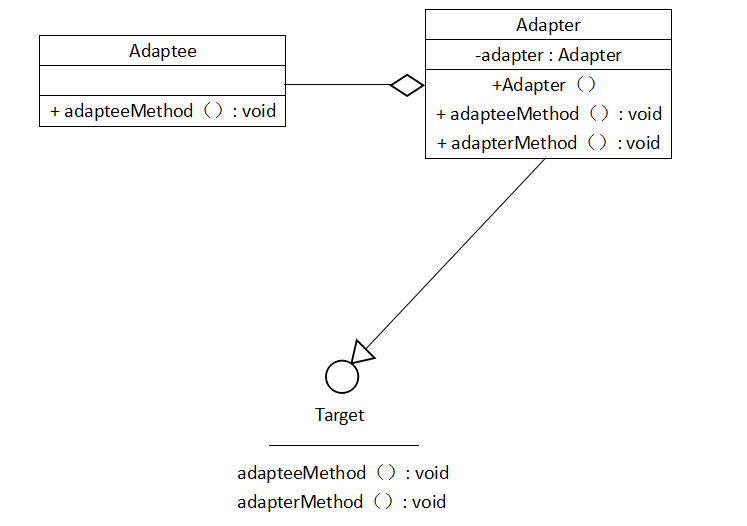
Target :
public interface Target
{
void adapteeMethod();
void adapterMethod();
}Adaptee:
public class Adaptee
{
public void adapteeMethod()
{
System.out.println("Adaptee method!");
}
}Adapter:
public class Adapter implements Target
{
private Adaptee adaptee;
public Adapter(Adaptee adaptee)
{
this.adaptee = adaptee;
}
public void adapteeMethod()
{
adaptee.adapteeMethod();
}
public void adapterMethod()
{
System.out.println("Adapter method!");
}
}Client :
public class Test
{
public static void main(String[] args)
{
Target target = new Adapter(new Adaptee());
target.adapteeMethod();
target.adapterMethod();
}
}result:
Adaptee method! Adapter method!
桥接模式
将抽象部分与它要实现部分分离,使它们都可以独立地变化。适用性:
1.你不希望在抽象和它的实现部分之间有一个固定的绑定关系。例如这种情况可能是因为,在程序运行时刻实现部分应可以有选择或者切换。 2.类的抽象以及它的实现都应该可以通过生成子类的方法加以扩充。这时Bridge模式使你可以对不同的抽象接口和实现部分进行组合,并分别对它们进行扩充。 3.对一个抽象的实现部分的修改应对客户不产生影响,即客户的代码不必重新编译。 4.正如在意图一节的第一个类图中所示的那样,有许多类要生成。这是一种类层次结构说明你必须将一个对象分解成两个部分。 5.想在多个对象间共享实现(可能使用引用计数),但同时要求客户并不知道这一点。
参与者:
1.Abstraction:定义抽象类的接口。维护一个指向Implementor类型对象的指针。 2.RefinedAbstraction:扩充由Abstraction定义的接口。 3.Implementor:定义实现类的接口,该接口不一定要与Abstraction的接口完全一致。事实上这两个接口可以完全不同。一般来讲,Implementor接口仅提供基本操作,而Abstraction则定义了基于这些基本操作的较高层次的操作。 4.ConcreteImplementor:实现Implementor接口并定义它的具体实现。
类图:
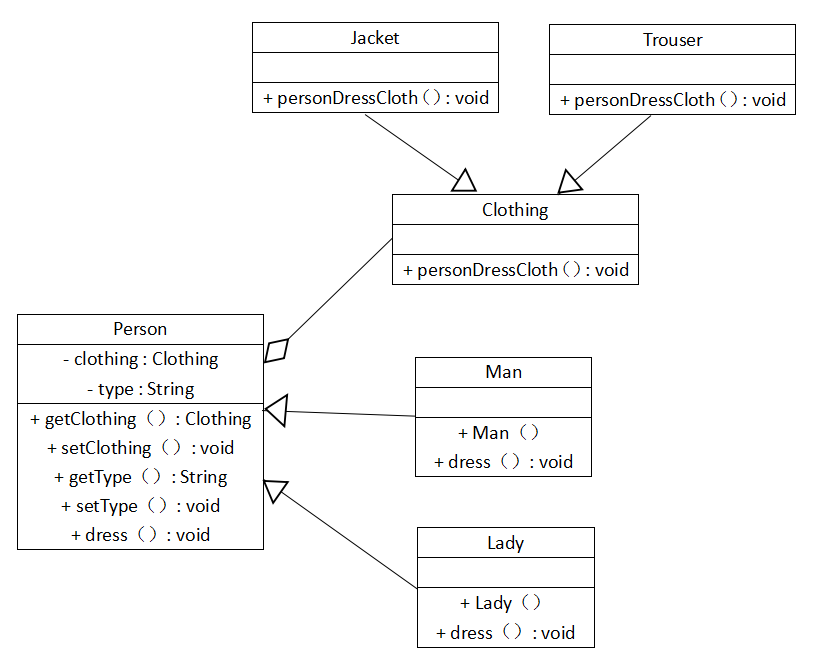
Abstraction:
public abstract class Person
{
private Clothing clothing;
private String type;
public Clothing getClothing()
{
return clothing;
}
public
void setClothing()
{
this.clothing = getClothing();
}
public void setType(String type)
{
this.type = type;
}
public String getType()
{
return this.type;
}
public abstract void dress();
}RefinedAbstraction:
public class Man extends Person
{
public Man()
{
setType("男人");
}
public void dress()
{
Clothing clothing = getClothing();
clothing.personDressCloth(this);
}
}public class Lady extends Person
{
public Lady()
{
setType("女人");
}
public void dress()
{
Clothing clothing = getClothing();
clothing.personDressCloth(this);
}
}Implementor:
public abstract class Clothing
{
public abstract void personDressCloth(Person person);
}ConcreteImplementor:
public class Jacket extends Clothing
{
public void personDressCloth(Person person)
{
System.out.println(person.getType() + "穿马甲");
}
}public class Trouser extends Clothing
{
public void personDressCloth(Person person)
{
System.out.println(person.getType() + "穿裤子");
}
}Test:
public class Test
{
public static void main(String[] args)
{
Person man = new Man();
Person lady = new Lady();
Clothing jacket = new Jacket();
Clothing trouser = new Trouser();
jacket.personDressCloth(man);
trouser.personDressCloth(man);
jacket.personDressCloth(lady);
trouser.personDressCloth(lady);
}
}result:
男人穿马甲 男人穿裤子 女人穿马甲 女人穿裤子
组合模式
将对象组合成树形结构以表示”部分-整体”的层次结构。Composite使得用户对单个对象和组合对象的使用具有一致性。适用性:
1.你想表示对象的部分-整体层次结构。 2.你希望用户忽略组合对象与单个对象的不同,用户将统一地使用组合结构中的所有对象。
参与者:
1.Component:为组合中的对象声明接口。在适当的情况下,实现所有类共有接口的缺省行为。声明一个接口用于访问和管理Component的子组件。(可选)在递归结构中定义一个接口,用于访问一个父部件,并在合*的情况下实现它。 2.Leaf:在组合中表示叶节点对象,叶节点没有子节点。在组合中定义节点对象的行为。 3.Composite :定义有子部件的*些部件的行为。存储子部件,在Component接口中实现与子部件有关的操作。 4.Client:通过Component接*操纵组合部件的对象。
类图:
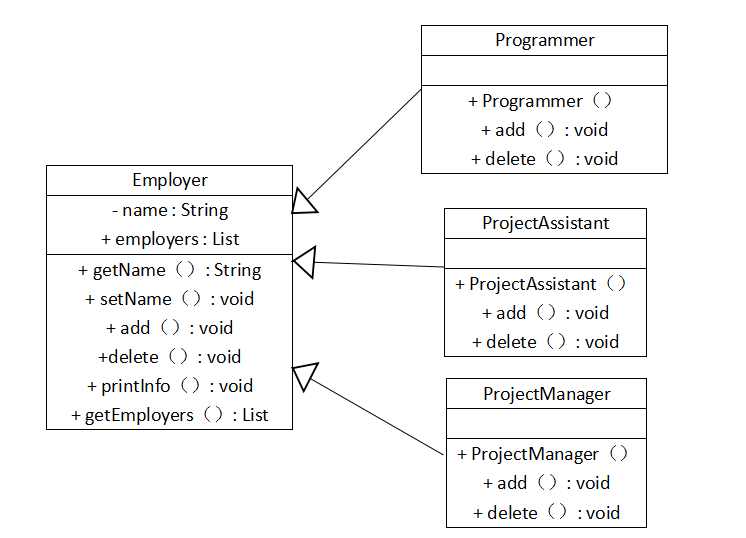
Component:
import java.util.List;
public abstract class Employer
{
private String name;
public void setName(String name)
{
this.name = name;
}
public String getName()
{
return this.name;
}
public abstract void add(Employer employer);
public abstract void delete(Employer employer);
public List employers;
public void printInfo()
{
System.out.println(name);
}
public List getEmployers()
{
return this.employers;
}
}Leaf:
public class ProjectAssistant extends Employer
{
public ProjectAssistant(String name)
{
setName(name);
employers = null;// 项目助理, 表示没有下属了
}
public void add(Employer employer)
{
}
public void delete(Employer employer)
{
}
}public class Programmer extends Employer
{
public Programmer(String name)
{
setName(name);
employers = null;// 程序员, 表示没有下属了
}
public void add(Employer employer)
{
}
public void delete(Employer employer)
{
}
}Composite :
import java.util.ArrayList;
public class ProjectManager extends Employer
{
public ProjectManager(String name)
{
setName(name);
employers = new ArrayList();
}
public void add(Employer employer)
{
employers.add(employer);
}
public void delete(Employer employer)
{
employers.remove(employer);
}
}Client:
import java.util.List;
public class Test
{
public static void main(String[] args)
{
Employer pm = new ProjectManager("项目经理");
Employer pa = new ProjectAssistant("项目助理");
Employer programmer1 = new Programmer("程序员一");
Employer programmer2 = new Programmer("程序员二");
pm.add(pa);// 为项目经理添加项目助理
pm.add(programmer2);// 为项目经理添加程序员
List<Employer> ems = pm.getEmployers();
for (Employer em : ems)
{
System.out.println(em.getName());
}
}
}result:
项目助理 程序员二
装饰模式
动态地给一个对象添加一些额外的职责。就增加功能来说,Decorator模式相比生成子类更为灵活。适用性:
1.在不影响其他对象的情况下,以动态、透明的方式给单个对象添加职责。 2.处理那些可以撤消的职责。 3.当不能采用生成子类的方法进行扩充时。
参与者:
1.Component:定义一个对象接口,可以给这些对象动态地添加职责。 2.ConcreteComponent:定义一个对象,可以给这个对象添加一些职责。 3.Decorator:维持一个指向Component对象的指针,并定义一个与Component接口一致的接口。 4.ConcreteDecorator:向组件添加职责。
类图:

Component:
public interface Person
{
void eat();
}ConcreteComponent:
public class Man implements Person
{
public void eat()
{
System.out.println("男人在吃");
}
}Decorator:
public abstract class Decorator implements Person
{
protected Person person;
public void setPerson(Person person)
{
this.person = person;
}
public void eat()
{
person.eat();
}
}ConcreteDecorator:
public class ManDecoratorA extends Decorator
{
public void eat()
{
super.eat();
reEat();
System.out.println("ManDecoratorA类");
}
public void reEat()
{
System.out.println("再吃一顿饭");
}
}public class ManDecoratorB extends Decorator
{
public void eat()
{
super.eat();
System.out.println("===============");
System.out.println("ManDecoratorB类");
}
}Test:
public class Test
{
public static void main(String[] args)
{
Man man = new Man();
ManDecoratorA md1 = new ManDecoratorA();
ManDecoratorB md2 = new ManDecoratorB();
md1.setPerson(man);
md2.setPerson(md1);
md2.eat();
}
}result:
男人在吃 再吃一顿饭 ManDecoratorA类 =============== ManDecoratorB类
外观模式
为子系统中的一组接口提供一个一致的界面,Facade模式定义了一个高层接口,这个接口使得这个子系统更加容易使用。适用性:
1.当你要为一个复杂子系统提供一个简单接口时。子系统往往因为不断演化而变得越来越复杂。大多数模式使用时都会产生更多更小的类。这使得子系统更具可重用性,也更容易对子系统进行定制,但这也给一些不需要定制子系统的用户带来一些使用上的困难。Facade可以提供一个简单的缺省视图,这一视图对大多数用户来说已经足够,而那些需要更多的可定制性的用户可以越过facade层。 2.客户程序与抽象类的实现部分之间存在着很大的依赖性。引入facade将这个子系统与客户以及其他的子系统分离,可以提高子系统的独立性和可移植性。 3.当你需要构建一个层次结构的子系统时,使用facade模式定义子系统中每层的入口点。如果子系统之间是相互依赖的,你可以让它们仅通过facade进行通讯,从而简化了它们之间的依赖关系。
参与者:
1.Service:服务所用的接口 2.Facade:知道哪些子系统类负责处理请求。将客户的请求代理给适当的子系统对象。 3.Subsystemclasses:实现子系统的功能。处理由Facade对象指派的任务。没有facade的任何相关信息;即没有指向facade的指针。
类图
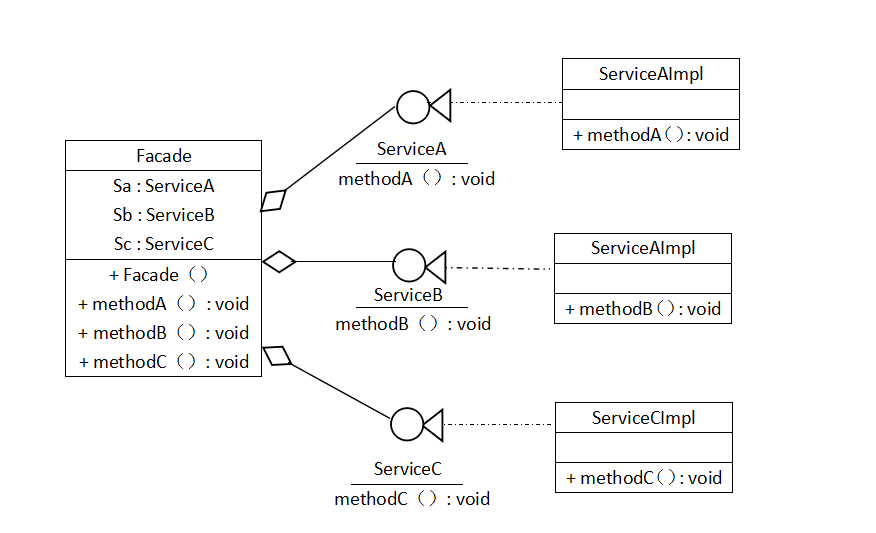
Service:
public interface ServiceA
{
void methodA();
}public interface ServiceB
{
void methodB();
}public interface ServiceC
{
void methodC();
}Facade:
public class Facade
{
ServiceA sa;
ServiceB sb;
ServiceC sc;
public Facade()
{
sa = new ServiceAImpl();
sb = new ServiceBImpl();
sc = new ServiceCImpl();
}
public void methodA()
{
sa.methodA();
sb.methodB();
}
public void methodB()
{
sb.methodB();
sc.methodC();
}
public void methodC()
{
sc.methodC();
sa.methodA();
}
}Subsystemclasses:
public class ServiceAImpl implements ServiceA
{
public void methodA()
{
System.out.println("这是服务A");
}
}public class ServiceBImpl implements ServiceB
{
public void methodB()
{
System.out.println("这是服务B");
}
}public class ServiceCImpl implements ServiceC
{
public void methodC()
{
System.out.println("这是服务C");
}
}Test:
public class Test
{
public static void main(String[] args)
{
ServiceA sa = new ServiceAImpl();
ServiceB sb = new ServiceBImpl();
sa.methodA();
sb.methodB();
System.out.println("========");
// facade
Facade facade = new Facade();
facade.methodA();
facade.methodB();
}
}result:
这是服务A 这是服务B ======== 这是服务A 这是服务B 这是服务B 这是服务C
享元模式
运用共享技术有效地支持大量细粒度的对象。适用性:
当都具备下列情况时,使用Flyweight模式: 1.一个应用程序使用了大量的对象 2.完全由于使用大量的对象,造成很大的存储开销 3.对象的大多数状态都可变为外部状态 4.如果删除对象的外部状态,那么可以使相对较少的共享对象取代很多组对象。 5.应用程序不依赖于对象标识。由于Flyweight对象可以被共享,对于概念上明显有别的对象,标识测试将返回真值。
参与者:
1.Flyweight:描述一个接口,通过这个接口flyweight可以接受并作用于外部状态。 2.ConcreteFlyweight:实现Flyweight接口,并为内部状态(如果有的话)增加存储空间。Concrete*lyweight对象必须是可共享的。它所存储的状态必须是内部的;即,它必须独立于ConcreteFlyweight对象的场景。 3.UnsharedConcreteFlyweight:并非所有的Flyweight子类都需要被共享。Flyweight接口使共享成为可能,但它并不强制共享。在Flyweight对象结构的某些层次,UnsharedConcreteFlyweight对象通常将ConcreteFlyweight对象作为子节点。 4.FlyweightFactory:创建并管理flyweight对象。确保合理地共享flyweight。当用户请求一个flyweight时,FlyweightFactory对象提供一个已创建的实例或者创建一个(如果不存在的话)。
类图:

Flyweight
public interface Flyweight
{
void action(int arg);
}ConcreteFlyweight
public class FlyweightImpl implements Flyweight
{
public void action(int arg)
{
// T*DO Auto-genera*ed method stub
System.out.println("参数值: " + arg);
}
}FlyweightFactory
import java.util.HashMap;
import java.util.Map;
public class FlyweightFactory
{
private static Map flyweights = new HashMap();
public FlyweightFactory(String arg)
{
flyweights.put(arg, new FlyweightImpl());
}
public static Flyweight getFlyweight(String key)
{
if (flyweights.get(key) == null)
{
flyweights.put(key, new FlyweightImpl());
}
return (Flyweight) flyweights.get(key);
}
public static int getSize()
{
return flyweights.size();
}
}Test
public class Test
{
public static void main(String[] args)
{
// TODO Auto-generated method stub
Flyweight fly1 = FlyweightFactory.getFlyweight("a");
fly1.action(1);
Flyweight fly2 = FlyweightFactory.getFlyweight("a");
System.out.println(fly1 == fly2);
Flyweight fly3 = FlyweightFactory.getFlyweight("b");
fly3.action(2);
Flyweight fly4 = FlyweightFactory.getFlyweight("c");
fly4.action(3);
Flyweight fly5 = FlyweightFactory.getFlyweight("d");
fly5.action(4);
System.out.println(FlyweightFactory.getSize());
}
}result
参数值: 1 true 参数值: 2 参数值: 3 参数值: 4 4
代理模式
为其他对象提供一种代理以控制对这个对象的访问。适用性:
1.远程代理(RemoteProxy)为一个对象在不同的地址空间提供局部代表。 2.虚代理(VirtualProxy)根据需要创建开销很大的对象。 3.保护代理(ProtectionProxy)控制对原始对象的访问。 4.智能指引(SmartReference)取代了简单的指针,它在访问对象时执行一些附加操作。
参与者:
1.Proxy:保存一个引用使得代理可以访问实体。若RealSubject和Subject的接口相同,Proxy会引用Subject。提供一个与Subject的接口相同的接口,这样代理就可以用来替代实体。控制对实体的存取,并可能负责创建和删除它。其他功能依赖于代理的类型。 2.RemoteProxy:负责对请求及其参数进行编码,并向不同地址空间中的实体发送已编码的请求。 3.VirtualProxy:可以缓存实体的附加信息,以便延迟对它的访问。 4.ProtectionProxy:检查调用者是否具有实现一个请求所必需的访问权限。 5.Subject:定义RealSubject和Proxy的共用接口,这样就在任何使用RealSubject的地方都可以使用Proxy。 6.RealSubject:定义Proxy所代表的实体。
类图:
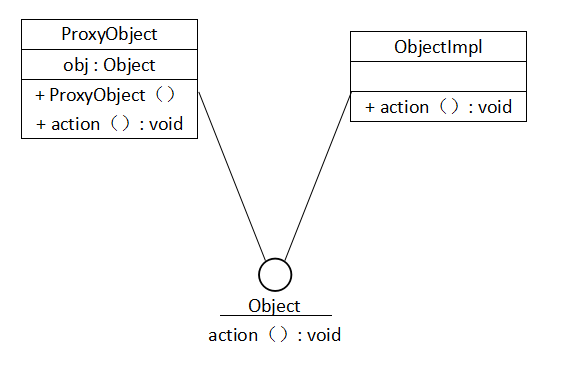
Proxy
public class ProxyObject implements Object
{
Object obj;
public ProxyObject()
{
System.out.println("这是代理类");
obj = new ObjectImpl();
}
public void action()
{
System.out.println("代理开始");
obj.action();
System.out.println("代理结束");
}
}Subject
public interface Object
{
void action();
}RealSubject
public class ObjectImpl implements Object
{
public void action()
{
System.out.println("========");
System.out.println("========");
System.out.println("这是被代理的类");
System.out.println("========");
System.out.println("========");
}
}Test
public class Test
{
public static void main(String[] args)
{
Object obj = new ProxyObject();
obj.action();
}
}result
这是代理类 代理开始 ======== ======== 这是被代理的类 ======== ======== 代理结束
相关文章推荐
- Java面象对向的基本思想(二)
- Java面象对向的基本思想(五)
- Java面象对向的基本思想(一)
- Java面象对向的基本思想(三)
- JAVA编程思想---基本数据类型总结(byte,char)
- Java的8大排序的基本思想及实例解读
- java面向对象基本思想--封装继承多态
- 监视锁——Java同步的基本思想
- Java的8大排序的基本思想及实例解读
- 基本算法思想Java实现的详细代码
- Java 编程思想12.2-基本异常
- Java的8大排序的基本思想及实例解读
- java中 MVC基本思想,优点,和具体指什么?
- 从0开始学java——JUnit4 复习,其实基本思想还是那些,不过采用了新的注释格式的语法
- Java基础学习12(Java SE图解以及Java基本思想讲解)
- Java语言中的面向对象特性:封装、继承、多态,面向对象的基本思想(总结得不错)
- 排序趟[置顶] Java和C实现的冒泡排序(基本思想)
- java面向对象思想(2)——三大基本特征
- 监视锁——Java同步的基本思想
- java基本数据类型的几点注意和面向对象思想
